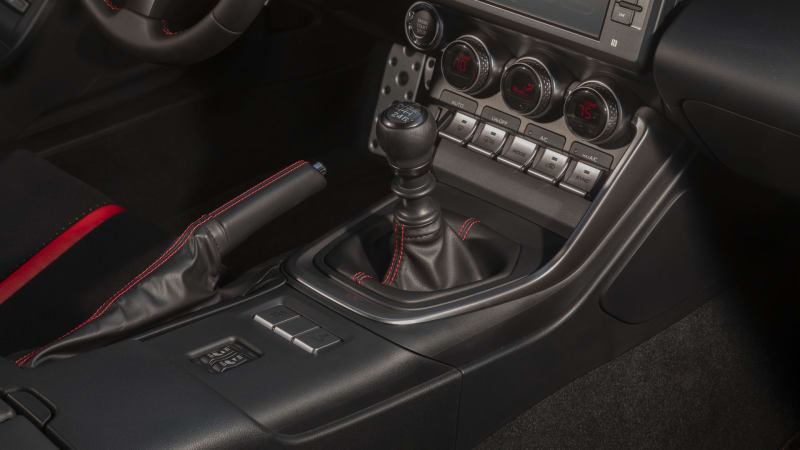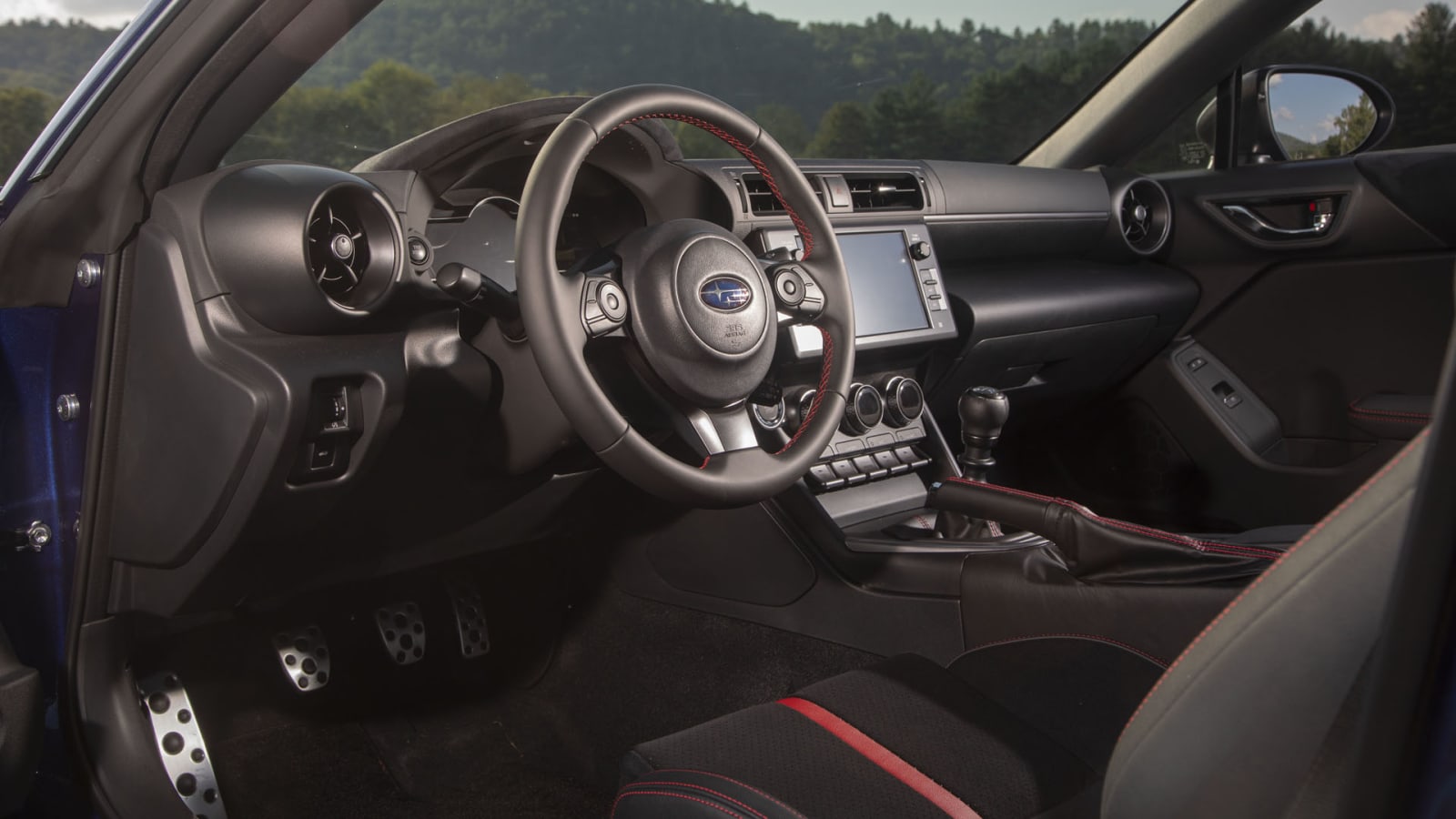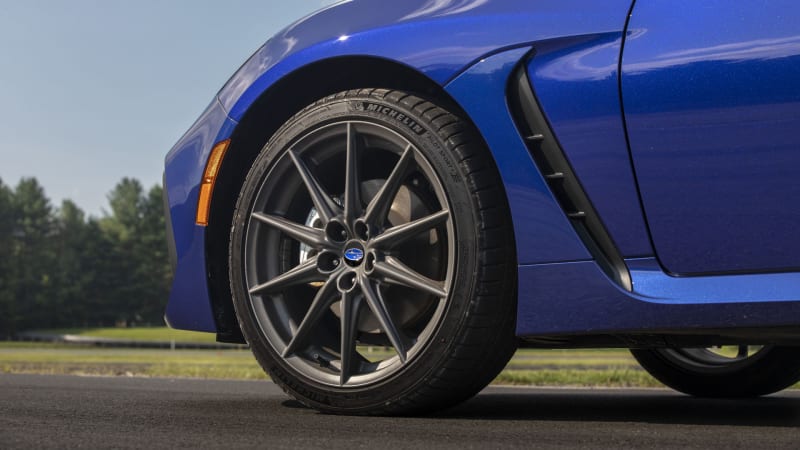SHARON, Conn. — Lime Rock Park racetrack, in the hilly country of far northwestern Connecticut, dates back to 1956 and was a cradle of sports car enthusiasm in America. Today, sports car enthusiasm in America seems to be edging toward the grave, as Americans instead embrace trucks and SUVs of every stripe (or just can’t afford an extra car as sports cars tend to be). But the new 2022 Subaru BRZ — together with its Toyota’s GR 86 sibling — is bucking the trend. And after driving it on this historic track and in the surrounding countryside, we’re happy to report that it now does an even better job reminding us why sports cars are worth saving.
There’s irony in Subaru, the brand of sensibly shaped all-wheel-drive wagons and crossovers, being one of the driving forces keeping sports cars alive. And yet, with the arrival of the second-generation BRZ, that’s exactly what has happened. The fact that there even is a new BRZ is kind of astonishing. The Subaru-Toyota collaboration that produced the original BRZ and Toyota 86 (nee Scion FR-S) was hardly smooth and hasn’t progressed beyond this single-car tie-up. Neither model is central to its brand’s market viability, either. Subaru claims that the 42,144 BRZs it has sold in the United States since 2013 is a better-than-expected result, but it still barely represents three months of Outback sales.
Once again, Subaru took the lead in engineering, while we can thank Toyota for the design. And those designers do deserve kudos. The new look is a clear evolution of the former, but there are significant changes. The greenhouse is narrower, giving the rear fenders a hippier look. Both the nose and the tail are more rounded, and the overall surface treatment is more curvaceous. There are new, fully functional front fender vents, the deck lid in upper-trim cars is topped off with a duckbill spoiler, and the “double-bubble” roofline returns. The net effect is more sports car and less sporty coupe.
In these times when every new model generation adds inches and pounds, the new BRZ is 1.2 inches longer, no wider and its roof peaks 0.4 inch lower. Good. The wheelbase is just 0.2 inch longer, the front track is unchanged, and rear track is just 0.4 inch wider. As we noted in our 86 first drive, this similarity between generations is the result of modifying the previous platform as opposed to starting off with a clean slate.



Keeping size in check is key to keeping weight in check. An aluminum roof and front fenders join the previous aluminum hood to assist in that effort. Curb weight is stated at 2,815–2,881 pounds, which represents an increase of less than 50 pounds. With the switch from a steel roof and fractionally lower overall height, the center of gravity is claimed to be just under 18 inches, lower than a Porsche 718 Boxster/Cayman or a Mazda Miata.
Once again, a Subaru engine sits under the hood. No, it’s not a turbo. Pleas for a turbocharged engine went unheeded, mostly to keep the BRZ affordable, we’re told. The new engine is more powerful, though. It’s a 2.4-liter (essentially, a naturally aspirated version of the Ascent engine) but is physically no larger or heavier than the old 2.0-liter. The extra displacement pushes output to 228 horsepower versus the previous 206/200 hp (manual/automatic). The more meaningful bump is in torque, which goes from 156 pound-feet to 184, and is far more accessible with the peak at 3,700 rpm compared to 6,400 rpm in the old engine. And the fall-off in torque that occurred in the previous engine at 4,000 rpm is largely gone.
As before, your transmission choices are a Toyota-supplied six-speed manual or a six-speed automatic, both driving the rear wheels via a Torsen limited-slip differential. The automatic now has a Sport mode with rev-matched downshifts, but the manual is still the way to go in a purist machine like this — and three-quarters of BRZ buyers agree. That it boasts short throws and a friendly, short-travel clutch is a nice bonus.
Additionally, the manual’s shorter gearing makes for notably livelier acceleration, although both setups are quicker than before. By Subaru’s measurement, the automatic chops 1.5 seconds from the previous 0-60 time, now 6.5 seconds, while the manual is 1.0-second quicker at 6.0. The difference in drivability between the two felt greater than that on the road, however, although neither version was breathless or wanting. And at the track, the manual was carrying notably more speed at the end of both the main straight and the back straight.
On the Lime Rock course, the nicely weighted steering provides actual feedback, and the BRZ felt stable and balanced. It takes a determined effort to upset this chassis — and on the dedicated autocross course, we had a lot of fun doing just that. As in the GR 86, the base car rides on 17-inch wheels with Michelin Primacy tires, while the upper-spec version gets 18-inch wheels with Michelin Pilot Sport 4 rubber. The latter have more grip, but both could be slid around the autocross once the stability control was switched into Track mode or turned off completely. While Normal or Sport modes keep the BRZ in the understeer zone, Track allows for easy throttle adjustability of your cornering angle and affords a pretty wide berth before it reels you in. Switch everything off, and it’s even possible to do some drifting.
There is some difference in chassis tuning between the Subaru and the Toyota. The Subaru suspension has stiffer front springs and softer rear springs. It also has aluminum knuckles rather than cast iron, a hollow rather than solid front antiroll bar, and a rear antiroll bar that’s mounted directly to the body rather than to the subframe. Subaru claims they tuned their version more for precision, while Toyota prioritized responsiveness. Unfortunately, none of our editors have driven both, but you can read our Toyota GR 86 first drive review where we at least had access to both first- and second-generation cars.
The BRZ is a playful companion on the track, but it doesn’t grow tiresome when you’re away from it. The roads in this bucolic corner of Connecticut and just across the border in New York have their share of patched and broken pavement, which the BRZ handled capably without the harshness often found in more extreme performance cars. The BRZ now pipes in synthetic engine noise that plays through a dedicated speaker, and while it doesn’t sound bad, we might want to turn down the volume once it crests 5,000 rpm. At lower engine speeds, road noise is predominant, but that’s not too surprising for a lightweight sports car on performance tires.
Subaru has added a bundle of EyeSight driver assists to the new BRZ: forward-collision warning with automatic emergency braking, lane-departure warning and adaptive cruise control. Unfortunately, those items are only for cars with the automatic transmission. The upper-spec Limited (with either transmission) now gets blind-spot monitoring and rear cross-traffic alert. Outward visibility to the rear is not great, but the narrow front pillars were quite helpful when looking ahead to the next corner at Lime Rock.

The cabin is treated to some welcome enhancements. The dash is less slab-like, and there are just enough padded/upholstered surfaces to keep the interior from seeming as cheap as the old one did. The base car has scratchy black cloth upholstery with red contrast stitching, but the Limited upgrades to Ultrasuede and leather with a red racing stripe down the center of the seats. Those seats have been redesigned and are genuinely comfortable. They have more prominent lateral support than before, and even after some intense lapping, you notice that you’re not having to brace yourself to maintain your driving position; the seat does a great job holding you in place.
The instrument cluster is another track-friendly item. It’s now screen-based, and shows either a round tachometer or a neat, band-style tach in Track mode, both in the display’s center. There’s also a flashing red upshift light as you approach redline, and a multi-function screen to the left that can be set up to show lap times, g forces, or horsepower and torque among other info.
The back seats are still just a place to toss your briefcase, your backpack or maybe your helmet, but that’s just fine. As before, they fold down, and a pass-through to the trunk allows the BRZ to carry a second set of tires and wheels, a bike with its front wheel removed, or two sets of golf clubs.


The infotainment touchscreen no longer looks like an aftermarket piece. The screen is enlarged from 6.5/7 inches (depending on trim) to 8 inches and is easy to use with several hard buttons plus knobs for volume and tuning. It’s basically what you get in Subaru’s other cars, which is just fine. You’ll have to use your phone for navigation, although Apple CarPlay and Android Auto are both included. On the subject of smartphones, in the stick-shift car there’s really nowhere to stash one other than inside the center armrest bin, where the two cupholders and the USB ports are located. The automatic version has an open cupholder just forward of that.
Prices range from $28,955 to $33,255 (including the $960 destination charge). Besides the upgraded wheels/tires, the upholstery, and the driver-assistance features, paying an extra $2,500 for the Limited gets you steering-responsive headlights, heated seats, and Starlink telematics.
Subaru hewed to the same formula with the new BRZ, and while the naysayers will focus on what it is not — turbocharged, all-wheel drive, a true four-seater — there is no shortage of larger, more powerful, more expensive performance cars. What are thin on the ground some 70 years after they first appeared are low-dollar, lightweight, lively sports cars. With the BRZ, Subaru has addressed its major shortcomings, making this example of a vanishing breed all the more desirable. Grab one while you still can.
Related Video:

